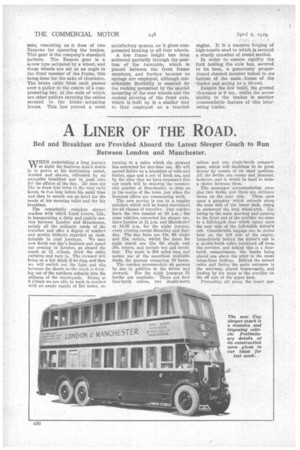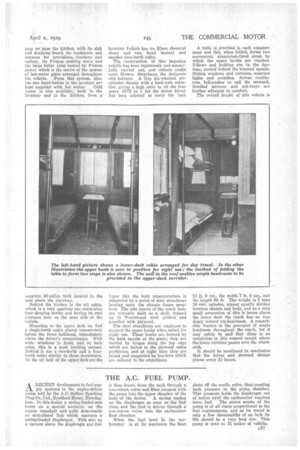A LINER OF THE ROAD.
Page 58

Page 59

If you've noticed an error in this article please click here to report it so we can fix it.
Bed and Breakfast are Provided Aboard the Latest Sleeper Coach to Run Between London and Manchester.
WHEN undertaking a long journey at night the business man's desire is to arrive at his destination rested, washed and shaven, refreshed by an enjoyable breakfast and in good lime for the affairs of the day. Ile does not like to draw into town ill the very early hours, to nee long before his usual time and then to search out an hotel for the needs of his morning toilet and for his breakfast.
The remarkably complete sleeper coaches with which Land Liners, Ltd., is Inaugurating a daily and nightly service between London and Manchester, satisfy all the ordinary needs of the traveller and offer a degree of comfort and service hitherto regarded as unobtainable in road journeys. We may now finish our day's business and spend our evening in London, go aboard the coach at 11 o'clock, draw the cabin curtains and turn in. The eteward will bring us a hot drink if we ring, and then we will switch out the light and slip between the sheets as the coach is drawing out of the northern suburbs into the stillness of the countryside. Rising at 8 o'clock we are able to wash in comfort with all ample supply of hot water, re turning to a cabin which the steward has converted for day-time use. Ile will spread before us a breakfast of rolls and butter, eggs and a pot of fresh tea, and by the time that we have consumed this our coach will be entering the commercial quarter of Manchester, to drop us Ia. the centre of the town just when the business offices are commencing work. .
The new service is run to a regular schedule which will be found convenient for all classes of traveller. Day coaches leave the two termini at 10 3.311. ; the same vehicles, converted for sleeper use, leave London at 11 p.m. and Manchester at .10.30 p.m. for the night journey, every evening except Saturday and Sunday, The day fares pre 12s. 6d. single and 23s. return, whilst the fares for night travel are 1s. 6d. single and 30s. return, and include bed and breakfast. The route is 204 miles long and makes use of the smoothest available eoads, the journey occupying 10 hours. The coaches accommodate 44 persons by day in addition to the driver and steward. For the night journeys 21 berths are available.-There are four four-berth cabins, two double-berth cabins and one single-berth compartment, which will doubtless he in great . favour by reason of its ideal position. All the berths are roomy and pleasant, however, and it would be hard to make a choice between them.
The passenger accommodation occupies two decks,' and there are entrance doors on the near side. These open upon a gangway which extends along the near side of the lower deck, rising to surmount the long wheel-arch. Entering-by the main doorway and passing to the front end of the corridor we come to a full-length door which opens upon the near side of the full-width driver's cab. Considerable luggage can be etorea here on the left side of the engine. Immediately behind the driver's cab is a double-berth cabin curtained off from the corridor, and behind this is a fourberth compartment, the bunks being placed one above the other in the usual ocean-liner fashion. Behind the second cabin and facing the main entrance is the stairway, placed transversely, and leading by six steps to the corridor 011 the off side of the upper deck.
Proceeding aft along the lower pas
sage we pass the kitchen, with its sink and draining-haard, its 'cupboards. and drawers for provisions.. Crockery and cutlery, its Primus Woking stove and the large boiler (also heated by Primus stove) which is the centre of the system of hot-water pipes arranged throughout the vehicle. From this system, also, the two hand-basins in the lavatory are
kept supplied with hot water. Cold water is also available, both in the lavatory and in the kitchen, from a separate 80 gallon tank located in the roof above the stairway.
Behind the kitchen is the aft cabin, which is a very spacious one containing four sleeping berths and having its own entrance door on the near side of the vehicle.
Mounting to the upper deck we find a single-berth cabin placed transversely before the front bulkhead, immediately above the driver's compartment. With wide windows in front and at both sides, this is a most inviting retreat. Behind it are a two-berth and a fourberth cabin similar to those downstairs. in the aft half of the upper deck are the lavatory (which has an Elsan chemical closet and two hand basins) and another four-berth cabin.
The construction of this imposing vehicle has been ingeniously and masterfully carried out, and reflects credit upon Messrs. Strachans, the designers and builders. A Guy six-wheeled, sixcylinder chassis with a back-axle reduction giving a high ratio to all the four gears (6.75 to 1 for the direct drive) has been selected to carry the load.
Upon this the body superstructure is supported by a series of steel stanchions bearing upon the chassis frame members. The side panels of the coach body are virtually built as a shell, framed up in T-sectioned steel girders and panelled with plywood.
The steel stanchions are employed to support the upper bunks when raised for night use. These bunks are formed by the back squabs of the seats; they are carried by hinges along the top edge which are bolted to the plywood cabin partitions, and at night time they are raised and supported by brackets which are collared to the stanchions. A table is provided in each compartment and this, when folded, forms two convenient, aluminium-faced steps by which the upper berths are reached. Pillows and bedding are, in the daytime, stowed behind the lowered squabs. Sliding windows and curtains, separate lights and switches, Airvac ventilators, bell-pushes to call the steward, bevelled mirrors and ash-trays are further adjuncts to comfort.
The overall height of this vehicle is 13 ft. 9 ins. the width 7 ft. 6 ins., and the length 31) ft. The weight is 7 tons 19 cwt. unladen, almost equally divided between chassis and body, and as a very small proportion of this is borne above the lower deck the coach has no tendency toward top-heaviness. A remarkable feature is the provision of ample headroom throughout the coach, for it may safely be said that there is no restriction in this respect except where the lower corridor passes over the wheelarch.
It should be mentioned in conclusion that the driver and steward change places every 2-i hours.












































































































